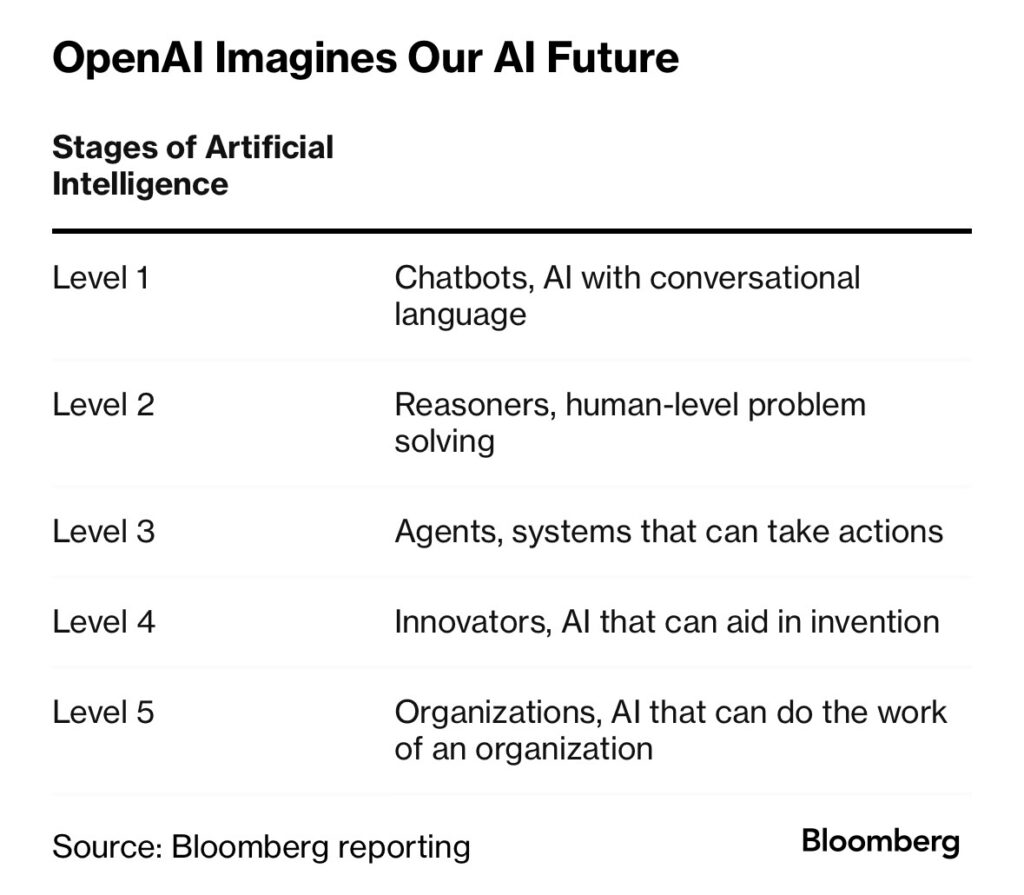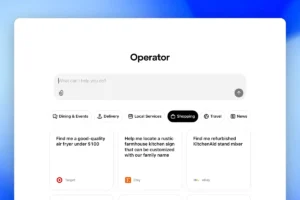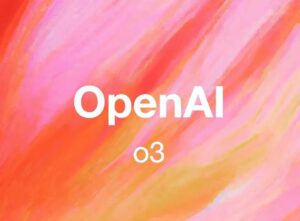
AInsights: Your executive-level insights making sense of the latest in generative AI…
OpenAI has outlined a five-level system to track the progress of artificial intelligence (AI) towards achieving human-level intelligence, also known as Artificial General Intelligence (AGI). According to an OpenAI spokesperson, the company told Bloomberg that the company is close to level two, “Reasoners,” where AI can perform problem-solving at the level of a human with a doctorate degree but no access to tools.
How close is OpenAI to level 2?
Let’s take a step back to understand the difference between where we are today with generative AI and how it compares to artificial general intelligence (AGI).
Generative AI and Artificial General Intelligence (AGI) represent two distinct stages in the evolution of artificial intelligence, each with unique capabilities and limitations.
Generative AI is currently a powerful tool for specific tasks involving content creation and pattern recognition, widely used across various industries to enhance productivity and creativity. However, it lacks true understanding and adaptability.
AGI is a type of AI that could learn to accomplish any intellectual task that human beings or animals can perform, or surpass human capabilities in the majority of economically valuable tasks. It represents the future goal of AI research, aiming to create machines with human-like cognitive abilities capable of understanding, learning, and innovating across diverse domains. While promising transformative potential, AGI remains a theoretical pursuit with significant challenges to overcome.
However, OpenAI detailed five stages that represent the evolution from genAI to AGI.
Let’s review a summary of each stage:
Level 1: Conversational AI (we are currently here)
At this initial stage, AI systems can engage in natural language conversations with humans. Examples include chatbots and virtual assistants like OpenAI’s ChatGPT. These systems can handle customer service interactions and provide basic assistance but are limited to language-based tasks and lack complex problem-solving abilities.
Level 2: Reasoners
The second stage involves AI systems capable of solving problems at the level of a human with a doctorate degree, but without access to external tools. These “Reasoners” are expected to excel in academic and professional fields, tackling complex problems independently. This marks a significant leap in AI’s cognitive abilities, enabling applications in research, medicine, and engineering.
Level 3: Agents
At this stage, AI systems, referred to as “Agents,” can autonomously perform tasks on behalf of users over an extended period. These systems can operate independently without constant human intervention, potentially revolutionizing business operations and efficiency by handling a variety of tasks across different domains.
Level 4: Innovators
The fourth level, known as “Innovators,” describes AI systems that can aid in developing new inventions. These systems can contribute to scientific discoveries and technological advancements by generating innovative solutions and ideas. This stage signifies AI’s ability to not just perform tasks but also to create and innovate.
Level 5: Organizations
The final stage envisions AI systems capable of performing the work of an entire organization. These “Organizations” can manage and execute all functions of a business, surpassing traditional human-based operations in terms of efficiency and productivity. This stage represents the pinnacle of AI development, where AI can autonomously run complex organizational structures.
OpenAI believes it is currently at Level 1 and is approaching Level 2. The timeline for achieving these advanced levels of AI varies, with estimates ranging from a few years to several decades. The progression through these stages highlights the incremental advancements in AI capabilities and the transformative potential of AGI.
Let’s revisit the question, how close is OpenAI to achieving level two, “Reasoners”?
The answer is a secret and appears to be codenamed “Project Strawberry.”
Project Strawberry aims to enhance AI’s reasoning capabilities, enabling models to plan ahead, navigate the internet autonomously, and perform deep research. The project builds on techniques like Stanford’s Self-Taught Reasoner (STaR), which allows AI models to iteratively create their own training data, thus improving their reasoning skills over time.
Current Capabilities and Demonstrations:
Recent demonstrations within OpenAI have shown promising strides towards human-like reasoning. For instance, internal tests have reportedly seen AI models scoring over 90% on challenging math tests, a significant indicator of advanced problem-solving abilities. These capabilities suggest that OpenAI is on the cusp of achieving the reasoning skills required for Level 2.
Challenges and Outlook:
Despite these advancements, the exact timeline for publicly releasing these capabilities remains, well, uncertain. From what I understand, the development process involves continuous fine-tuning and testing to ensure reliability and effectiveness. While there have been significant advancements, the leap from current capabilities to fully achieving Level 2 is still a work in progress.
I guess we’ll know when they’re ready for us to know.
AInsights
What do openAI’s five stages of artificial intelligence mean for business and technology executives?
For business and technology executives, OpenAI’s five stages of AI development present both opportunities and challenges. Embracing and strategically leveraging these advancements can lead to significant improvements in efficiency, innovation, and competitive advantage.
Stage 1: Chatbots
Customer Service: AI systems like ChatGPT and ServiceNow’s Now Assist are already enhancing customer service by providing 24/7 support, handling routine inquiries, and improving customer satisfaction.
Internal Productivity: Businesses are using chatbots for internal functions such as employee onboarding, IT support, and HR inquiries, streamlining operations and reducing costs.
Considerations:
User Experience: Investing in user-friendly interfaces and continuous improvement of chatbot capabilities is essential to maximize their effectiveness.
Stage 2: Reasoners
Advanced Problem-Solving: AI systems at this stage can solve complex problems at a level comparable to a human with a doctorate degree. This can revolutionize fields like research, finance, and engineering by providing expert-level insights and solutions without human intervention.
Strategic Decision-Making: Businesses can leverage these AI systems for strategic planning, risk assessment, and data analysis, enhancing decision-making processes.
Considerations:
Integration: Ensuring these advanced AI systems integrate seamlessly with existing business processes and tools is critical.
Ethical Use: Establishing guidelines for ethical use and addressing potential biases in AI decision-making is essential to maintain trust and compliance. Ethics also apply from this stage through to stage 5 in how employers upskill and augment workers with AI.
Organizational and business model innovation: Here and through every stage, C-suites will need to think forward to reimagine organizational and business model transformation to prepare for the coming autonomous enterprise.
Stage 3: Agents
Autonomous Operations: AI agents can perform tasks autonomously over extended periods, potentially transforming business operations by handling complex workflows without constant human supervision. This sets the stage for an autonomous, self-driving enterprise.
Operational Efficiency: These agents can optimize supply chains, manage logistics, and even handle customer relations autonomously, significantly improving efficiency and reducing operational costs.
Considerations:
Monitoring and Control: Implementing robust monitoring systems to oversee AI agents and ensure they are performing tasks correctly and ethically.
Adaptability: Ensuring AI agents can adapt to changing business environments and requirements is crucial for long-term success.
Stage 4: Innovators
Innovation and R&D: AI systems capable of innovation can contribute to new product development, scientific research, and technological advancements, potentially leading to breakthroughs in various industries.
Competitive Advantage: Businesses that harness innovative AI can gain a significant competitive edge by bringing new products and solutions to market faster.
Considerations:
Collaboration: Encouraging collaboration between AI systems and human experts to maximize innovative potential.
Intellectual Property: Managing intellectual property rights and ensuring that innovations generated by AI are protected and leveraged effectively.
Stage 5: Organizations
Complete Automation (the autonomous enterprise): AI systems at this stage can perform the work of an entire organization, from strategic planning to operational execution, potentially making traditional organizational structures obsolete
Efficiency and Productivity: Stage 5 AI systems can operate with unparalleled efficiency, reducing costs and increasing productivity across all business functions.
Considerations:
Human Workforce: Addressing the implications for the human workforce, including potential job displacement and the need for reskilling and upskilling.
Governance and Ethics: Establishing governance frameworks to ensure AI systems operate ethically, transparently, and in alignment with organizational goals and societal values.
Understanding and preparing for each stage, now, is absolutely crucial for navigating the future landscape of AI-driven business transformation.
Please subscribe to AInsights, here.
If you’d like to join my master mailing list for news and events, please follow, a Quantum of Solis.


Brian Solis | Author, Keynote Speaker, Futurist
Brian Solis is world-renowned digital analyst, anthropologist and futurist. He is also a sought-after keynote speaker and an 8x best-selling author. In his new book, Lifescale: How to live a more creative, productive and happy life, Brian tackles the struggles of living in a world rife with constant digital distractions. His previous books, X: The Experience When Business Meets Design and What’s the Future of Business explore the future of customer and user experience design and modernizing customer engagement in the four moments of truth.
Invite him to speak at your next event or bring him in to your organization to inspire colleagues, executives and boards of directors.





Leave a Reply